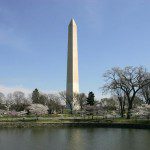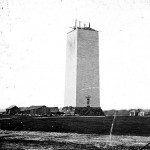The Iconic Obelisk
By • June 18, 2013 0 1705

The Washington Monument is the single most recognized icon in our cityscape, yet its creation had a turbulent beginning, middle and end. And it’s not over, as the federal government has just committed over $7 million to repair the cracks caused by the 2011 earthquake.
To start at the beginning, in 1783, Congress decreed that an equestrian statue should be built to honor the father of our country. So in 1791, Pierre L’Enfant chose the perfect triangulated site in relation to the rest of the National Mall to honor George Washington’s initial career as a surveyor.
Fundraising discussions ensued in 1799, and in 1836 a contest was held to choose a design for the monument. Architect Robert Mills won with a design of a simple obelisk surrounded by a fancy rotunda, topped off by Washington at the helm of a chariot led by a team of charging horses. The fundraising goal of $1 million was slow getting off the ground, with only $30,000 collected by 1836, but construction started
anyway in 1848. It stopped six years later when they ran out of money.
The whole city made fun of the 153-foot stump that dominated the Mall until 1876, when construction resumed, but with a different color of stone (just in case Washingtonians needed a reminder of what happens when Congress starts a project).
The obelisk was completed in 1884, but not without controversy. For one thing, it was built on a completely different spot than L’Enfant had chosen. It turned out that the Mall was so swampy, the cornerstone Jefferson originally laid sunk and disappeared into the mire. So, a more solid site had to be found.
Then there was the incident involving Pope Pius IX, who donated a stone to the monument that was subsequently stolen by the infamous Know-Nothing Party in a wave of anti-Catholicism. At the same time,
two new variations of design were proposed. One involved creating an Italian bell tower at the top of the
obelisk and the other idea was to make it into a copy of “one of the better Hindu pagodas”, to quote a
local newspaper article.
The plans for pagodas, bell towers and rearing horses were scrapped and the simple monument stands as one of the best in the city. At 555 feet and 5 1/8 inches high – give or take a fraction after the earthquake – it remains one of the tallest masonry structure in the world, perhaps an inadvertent tribute to George Washington, who was a devoted Freemason.
Donna Evers, DEvers@EversCo.com, is the owner and broker of Evers & Co. Real Estate, the largest woman owned and run real estate firm in the Washington Metro area; the proprietor of Twin Oaks Tavern Winery in Bluemont, Virginia; and a devoted student of Washington area history.
- The early stages of the Washington Monument’s construction, in the 1850s.



